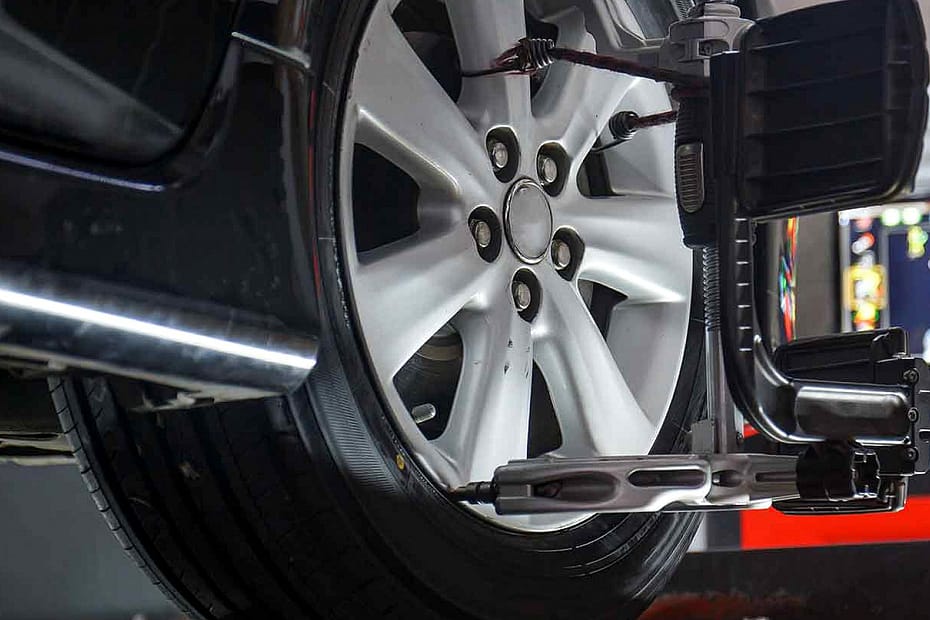Tire alignment is the process of adjusting the angles of a vehicle’s wheels to ensure they are parallel and perpendicular to each other and the road, promoting even tire wear and optimal vehicle performance. Improper alignment can lead to uneven tire wear, decreased fuel efficiency, and a less stable and safe driving experience.
Getting your tire alignment checked and adjusted regularly is crucial for maintaining the longevity of your vehicle’s tires and ensuring their performance. Misaligned tires can cause uneven tread wear, resulting in the need for premature replacements. Not only does this lead to additional expenses, but it can also compromise your vehicle’s handling and safety.
Regular alignment services also optimize fuel efficiency by reducing rolling resistance and uneven wear and tear. By maintaining proper alignment, you can prevent potential issues and enjoy a smoother, safer driving experience.

Credit: www.linkedin.com
Importance Of Tire Alignment
Tire alignment is vital for even tread wear and optimal vehicle handling. Proper alignment helps maintain stability and extends tire lifespan, improving overall driving safety and performance. It ensures equal distribution of pressure on all tires, contributing to fuel efficiency and reducing the risk of premature wear.
Safety On The Road
Tire alignment is an important aspect of vehicle maintenance that is often overlooked by many drivers. However, the importance of tire alignment cannot be stressed enough, especially when it comes to safety on the road. When your tires are not properly aligned, it can lead to a variety of safety issues that can jeopardize your well-being and the well-being of others on the road.
First and foremost, improper tire alignment can affect your vehicle’s handling and stability, making it difficult for you to maintain control, especially in emergency situations. This is particularly dangerous when driving at high speeds or on wet or slippery roads. By ensuring your tires are properly aligned, you can have peace of mind knowing that your vehicle will respond predictably to your commands, allowing you to safely navigate through various traffic conditions.
Moreover, when your tires are not aligned, it can cause uneven tire wear. This means that certain areas of the tire will wear down faster than others, resulting in a less effective grip on the road. Reduced tire grip can lead to longer braking distances, decreased traction, and increased risks of skidding or hydroplaning. By maintaining proper alignment, you can ensure that your tires wear evenly, maximizing their grip on the road and ultimately enhancing your safety.
Another safety concern related to tire alignment is the potential for increased fuel consumption. When your tires are misaligned, it can create unnecessary drag on your vehicle, requiring more fuel to maintain the same speed. This not only puts a dent in your wallet but also contributes to your carbon footprint. By keeping your tires properly aligned, you can optimize your vehicle’s fuel efficiency, reducing emissions and saving money in the long run.
Extended Tire Lifespan
In addition to its impact on safety, proper tire alignment also plays a pivotal role in extending the lifespan of your tires. Uneven tire wear, caused by misalignment, can significantly reduce the longevity of your tires, requiring premature replacements. When your tires wear out unevenly, it means that certain areas of the tire are carrying more weight and experiencing more pressure than others, leading to accelerated tire deterioration.
By regularly aligning your tires, you can ensure that each tire carries an equal amount of weight and pressure, promoting even wear and tear. This not only extends the lifespan of your tires but also saves you money in the long run, as you won’t have to replace them as frequently. Additionally, by maintaining proper alignment, you can also prevent unnecessary wear on other vehicle components, such as the suspension system, ensuring the overall longevity of your vehicle.
Signs Of Misaligned Tires
Your vehicle’s tire alignment refers to the proper positioning of the wheels in relation to each other and the road. When your tires are misaligned, it can lead to a range of issues that can affect your driving experience, safety, and even your wallet. It’s important to be aware of the signs of misaligned tires so that you can take prompt action to address the problem.
Uneven Tire Wear
One of the most obvious signs of tire misalignment is uneven tire wear. When your tires are not aligned correctly, certain areas of the tire tread will experience increased friction and wear, while others may remain relatively untouched. This can be easily identified by inspecting your tires for signs of uneven or feathered tread wear. If you notice that one side of a tire is more worn out than the other, it’s time to have your alignment checked.
Vehicle Pulling To One Side
Another noticeable sign of misaligned tires is a constant pulling or drifting sensation while driving. When your tires are not properly aligned, the uneven distribution of weight can cause your vehicle to pull to one side, even when you try to steer straight ahead. This can not only be frustrating to deal with but is also a safety concern, especially when driving on wet or slippery roads.
Benefits Of Proper Wheel Alignment
Proper wheel alignment is crucial for several reasons beyond just ensuring that your vehicle is driving straight. Let’s explore the various advantages that come with maintaining a well-aligned set of wheels.
Improved Fuel Efficiency
Improved fuel efficiency is one of the key perks of having properly aligned wheels. When your wheels are out of alignment, your tires have to work harder, leading to increased friction with the road. This extra resistance results in your engine needing to use more fuel to propel the vehicle forward, ultimately decreasing the overall fuel economy.
Enhanced Vehicle Handling
Enhanced vehicle handling is another significant benefit of maintaining proper wheel alignment. When your wheels are correctly aligned, it ensures that your vehicle moves in the intended direction with minimal effort. This not only makes for a smoother driving experience but also enhances safety on the road by providing better control and maneuverability, especially in challenging driving conditions.

Credit: www.philsservice.com
Tire Alignment Process
Tire Alignment is a crucial aspect of vehicle maintenance, ensuring optimal performance and safety. Let’s delve into the detailed Tire Alignment Process to understand its importance.
Initial Inspection
Before the alignment procedure, a technician checks the current alignment status of the tires using specialized tools.
Adjustment Procedure
- Based on the inspection, adjustments are made to the camber, caster, and toe angles to ensure proper alignment.
- These adjustments are vital for even tire wear, improved handling, and overall vehicle stability.
- Technicians use precision equipment to align the tires accurately according to the manufacturer’s specifications.
Diy Vs Professional Wheel Alignment
DIY vs Professional Wheel Alignment
Pros And Cons Of Diy
DIY: Alignment kits available online. Professional: Precise technology and expertise.
- DIY is cost-effective but may lack accuracy.
- Professional service offers precision for safety.
- Risk of errors with DIY methods.
- Professionals ensure proper alignment for longevity.
Expertise Of Professional Service
Experienced technicians use advanced equipment Professional: Corrects alignment comprehensively.
- Professionals diagnose root issues accurately.
- Detailed adjustments for optimal tire performance.
- DIY: Possibility of overlooking critical alignment angles.
- Experts provide tailored solutions for vehicle needs.

Credit: fredsautorepair.com
Frequently Asked Questions Of What Is Tire Alignment
How Do You Know If You Need Alignment?
Alignment is needed if you notice uneven tire wear, your vehicle pulls to one side, or you experience steering wheel vibration. It’s also necessary after hitting a curb or pothole. Regular alignment helps ensure optimal handling, tire performance, and extends the life of your tires.
What Do They Do During A Tire Alignment?
During a tire alignment, the technician adjusts the angles of your vehicle’s tires, including the camber, caster, and toe. This ensures that all four tires are parallel and facing the correct direction, which helps improve vehicle handling, tire wear, and overall safety on the road.
Is Tire Alignment Really Necessary?
Yes, tire alignment is necessary as it ensures even tire wear and proper handling. Proper alignment also improves fuel efficiency and extends the life of your tires. It’s important to have your alignment checked regularly to maintain the performance and safety of your vehicle.
How Often Should I Get An Alignment?
Get an alignment every 6,000 miles or if you notice steering issues like pulling. Regular alignments ensure smooth driving.
Conclusion
In essence, tire alignment is crucial for maintaining vehicle safety and performance. By ensuring that the wheels are properly aligned, you can prevent uneven tire wear and improve fuel efficiency. Regular alignment checks can also save you money in the long run by extending the lifespan of your tires.
Overall, prioritizing tire alignment is essential for a smooth and safe driving experience.
